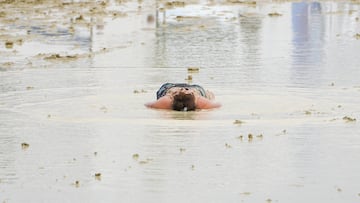What are the prehistoric three-eyed ‘dinosaur shrimp’ resurfacing at Burning Man?
The Burning Man festival this year was marred by flooding and mud, and from these conditions a prehistoric creature has proliferated- the dinosaur shrimp.


Thousands were stranded at the Burning Man festival due to torrential rains and floods. Two to three months worth of rain came pouring down in only a span of 24 hours. These muddy conditions were ideal for a prehistoric animal to emerge.
What are the prehistoric three-eyed ‘dinosaur shrimp’ resurfacing at Burning Man?
A small, strange-looking creature has started to proliferate in the Nevada Desert where the Burning Man Festival was held. These three-eyed animals are called Triops (for their three eyes), and they are also known as dinosaur, fairy, or tadpole shrimp.
According to Live Science, they are freshwater crustaceans which are technically not shrimp. Their third eye is called an ocellus eye which only functions for them to detect light.
READ ALSO: What caused the flooding and the mud at Burning Man festival in Nevada?
The human festival is over, but for Triops and fairy shrimp, it's just getting started.https://t.co/7TbUMuW9ed
— IFLScience (@IFLScience) September 4, 2023
They are sometimes called dinosaur shrimp because they have a prehistoric appearance and are considered living fossils due to their evolutionary history dating back hundreds of millions of years.
Triops are known for their ability to survive in temporary pools of water, such as puddles and ponds, and they have changed very little in terms of their basic morphology over the time that they have existed.
READ ALSO: Friday deluge sweeps away Burning Man festival in the Nevada desert
Triops have enduring eggs
Triops have a short and relatively simple life cycle. They start as tiny eggs that can survive long periods of drought. The eggs can last up to 27 years, after which they can still hatch if exposed to water.
Related stories
When these eggs get wet, they hatch into small nymphs. These nymphs grow rapidly, reproducing quickly, and typically only live for a few months. This short life cycle is one of the reasons they can thrive in temporary aquatic habitats.
Under the right conditions, these animals can suddenly hatch in large numbers, which is exactly what happened at the Burning Man, where temporary water pools were suddenly formed in typically arid conditions.

